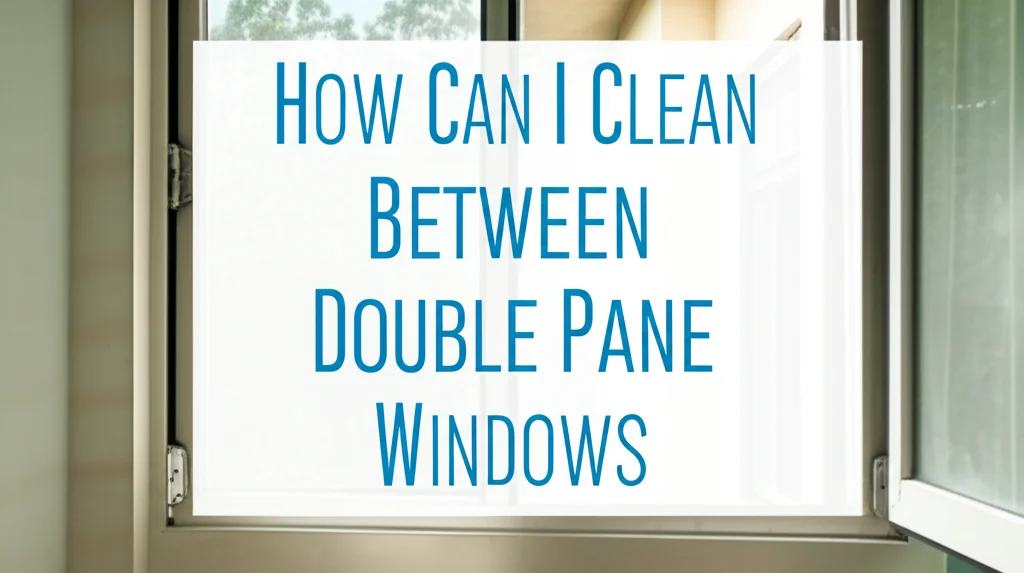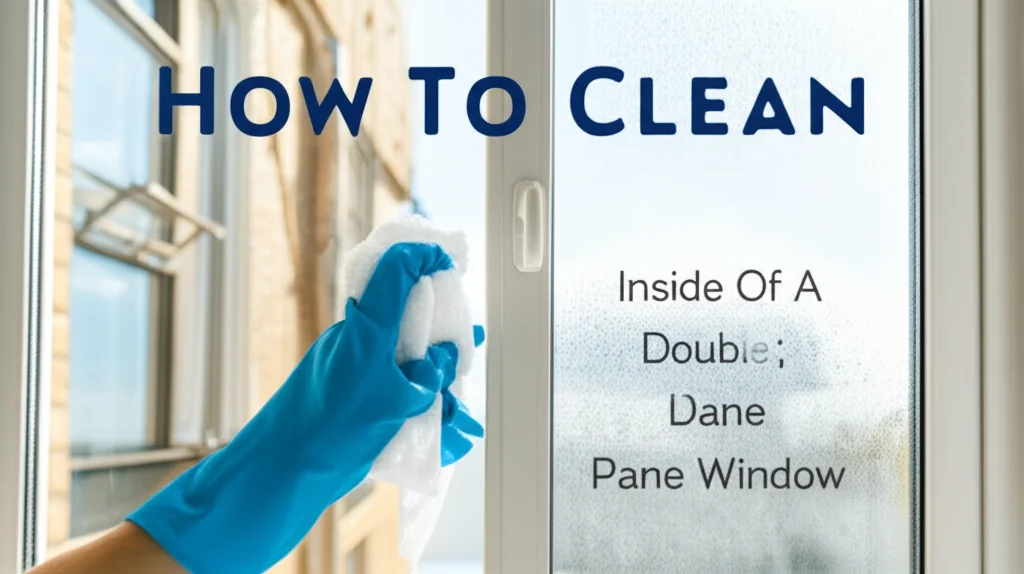· Home Cleaning · 8 min read
How To Clean Inside Of Double Pane Windows

Sparkling Clear: How To Clean Inside Of Double Pane Windows
Have you noticed streaks, grime, or even condensation building up between the panes of your double-pane windows? It’s a common problem, and thankfully, it’s often solvable without replacing the entire window! Cleaning inside double pane windows can seem daunting, but with the right approach, you can restore clarity and enjoy unobstructed views. This article will guide you through the process, covering everything from identifying the issue to safely cleaning the space between the glass. We’ll explore different methods, preventative measures, and when it’s time to call a professional. Let’s get started on making your windows shine!
Quick Answer: Cleaning inside double pane windows usually involves removing the window sash, carefully cleaning each pane with a glass cleaner and microfiber cloth, and then reassembling the window. If condensation is the issue, desiccant packs can help absorb moisture.
Takeaway:
- Identify the source of the problem (dirt, condensation, seal failure).
- Prioritize safety when disassembling and handling window components.
- Use gentle cleaning solutions to avoid damaging the glass or seals.
- Consider preventative measures to minimize future buildup.
Understanding Why Your Double Pane Windows Get Dirty
Double pane windows are designed to be energy efficient, but they aren’t immune to dirt and moisture. The space between the panes isn’t sealed perfectly forever. Over time, the seal can weaken, allowing air and moisture to enter. This is where the problems begin. Understanding why your windows are dirty is the first step to fixing them.
- Seal Failure: A broken seal is the most common cause of interior condensation and dirt buildup. It allows humid air to enter, condense on the cold glass, and trap dust.
- Desiccant Saturation: Double pane windows contain a desiccant (a drying agent) to absorb any initial moisture. Over time, this desiccant becomes saturated and can no longer do its job.
- Initial Manufacturing Debris: Sometimes, small particles of dust or debris are trapped inside during the manufacturing process. These can become visible over time.
- Temperature Fluctuations: Significant temperature changes can cause condensation, even with a good seal, especially in colder climates.
Assessing the Situation: Is It a DIY Project?
Before you start taking your windows apart, it’s important to assess the extent of the problem. A simple cleaning might be all you need, but a failed seal requires a different approach. Carefully examine your windows to determine the best course of action.
- Minor Condensation: If you only see a little condensation in the corners, especially during cold weather, the desiccant might just be saturated. This is often a DIY fix.
- Significant Condensation: If condensation is widespread and persistent, it likely indicates a seal failure. While you can try to clean it, the problem will likely return.
- Visible Dirt & Debris: If you see a lot of dust, dirt, or debris between the panes, cleaning is a good first step.
- Cloudy or Discolored Glass: If the glass itself appears cloudy or discolored, it could be a sign of irreversible damage, and replacement might be necessary.
Safely Disassembling Your Double Pane Window
Disassembling a double pane window requires patience and care. Always prioritize safety and work methodically. Different windows have different construction methods, so consult your window manufacturer’s instructions if available.
- Gather Your Tools: You’ll need a flathead screwdriver, putty knife, utility knife, and potentially a heat gun (for stubborn putty).
- Remove the Window Sash: Carefully remove the window sash from the frame. This usually involves releasing clips or screws.
- Remove the Glazing: The glazing (the material holding the glass in place) needs to be removed. This could be putty, glazing beads, or a combination of both. Use a putty knife or utility knife to carefully loosen and remove the glazing. A heat gun can soften old, hardened putty.
- Separate the Panes: Once the glazing is removed, carefully separate the two panes of glass. Be gentle, as the glass can be fragile.
Cleaning the Glass Panes: The Right Tools & Techniques
Now that you have access to the inside of the double pane window, it’s time to clean it. Using the right tools and techniques will ensure a streak-free finish and prevent damage.
- Choose Your Cleaning Solution: A simple solution of equal parts white vinegar and distilled water works well. You can also use a commercial glass cleaner, but avoid anything with ammonia, as it can damage the seals.
- Microfiber Cloths are Key: Use clean, lint-free microfiber cloths. Paper towels can leave streaks.
- Spray & Wipe: Lightly spray the cleaning solution onto the glass and wipe it clean with a microfiber cloth. Use a separate dry cloth to buff the glass to a shine.
- Stubborn Grime: For stubborn grime, let the cleaning solution sit for a few minutes before wiping. You can also use a plastic scraper (carefully!) to remove stuck-on debris.
- Cleaning the Spacers: Don’t forget to clean the spacers (the material between the glass panes). These can accumulate dust and grime.
Addressing Condensation: Using Desiccant Packs
If condensation is the primary issue, replacing the desiccant can help. However, this is a temporary fix if the seal is failing.
- Locate the Desiccant: The desiccant is usually located at the bottom of the window, inside the spacer.
- Remove the Old Desiccant: Carefully remove the old, saturated desiccant.
- Replace with New Desiccant: You can purchase desiccant packs online or at hardware stores. Place the new desiccant packs in the same location as the old ones.
- Reseal (If Possible): If you’re comfortable, you can attempt to reseal the window with a silicone sealant designed for windows. However, this is often a temporary fix.
Reassembling Your Window & Preventative Measures
Once the glass is clean and the desiccant (if applicable) has been replaced, it’s time to reassemble the window. Take your time and ensure everything is properly sealed.
- Apply New Glazing: Apply new glazing (putty or glazing beads) to secure the glass panes.
- Reinstall the Sash: Carefully reinstall the window sash into the frame.
- Preventative Measures:
- Ventilation: Ensure proper ventilation in your home to reduce humidity.
- Dehumidifier: Use a dehumidifier in areas prone to condensation.
- Regular Cleaning: Clean your windows regularly to prevent dirt buildup.
- Inspect Seals: Periodically inspect the window seals for any signs of damage.
When to Call a Professional
While many double pane window cleaning issues can be addressed DIY, some situations require professional help. Don’t hesitate to call a window repair specialist if:
- Seal Failure is Extensive: If the seal is severely damaged, replacing the glass unit is often the best solution.
- You’re Uncomfortable Disassembling the Window: If you’re not confident in your ability to safely disassemble and reassemble the window, it’s best to leave it to a professional.
- The Glass is Damaged: If the glass is cracked or broken, it needs to be replaced by a professional.
- You’ve Tried Everything and the Problem Persists: If you’ve tried cleaning and replacing the desiccant, and the problem still persists, it’s likely a more serious issue that requires professional attention.
FAQ: Your Double Pane Window Cleaning Questions Answered
Q: Can I use Windex to clean inside my double pane windows? A: While Windex can be used, it’s best to avoid ammonia-based cleaners as they can potentially damage the window seals over time. A vinegar and water solution is a safer alternative.
Q: How long does it take for desiccant packs to work? A: It can take several days or even weeks for desiccant packs to absorb moisture. Monitor the condensation levels to see if they are improving.
Q: Is it worth repairing a double pane window, or should I just replace it? A: It depends on the extent of the damage. If only the seal is failing, repairing the glass unit is often more cost-effective than replacing the entire window. However, if the glass is damaged or the frame is also deteriorating, replacement might be the better option.
Q: How can I prevent condensation from forming in the first place? A: Maintaining proper ventilation, using a dehumidifier, and ensuring your home is adequately insulated can help prevent condensation.
Q: What if I can’t get the old putty off the window? A: A heat gun can soften old, hardened putty, making it easier to remove. Be careful not to overheat the glass.
Q: Can I use a steam cleaner on double pane windows? A: It’s generally not recommended to use a steam cleaner on double pane windows. The extreme heat can potentially damage the seals and cause the glass to crack.
Conclusion: Enjoying Clear Views Again
Cleaning inside double pane windows can be a rewarding DIY project, restoring clarity and improving your home’s energy efficiency. Remember to prioritize safety, use the right tools and techniques, and assess the situation carefully before you begin. If you’re unsure about any step, don’t hesitate to call a professional. By following these tips, you can enjoy crystal-clear views and a more comfortable home. Don’t let dirty windows cloud your day – take action and bring the sunshine back in!




